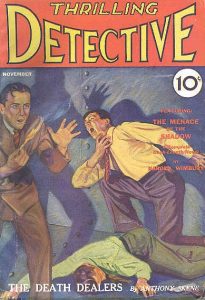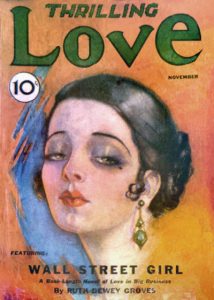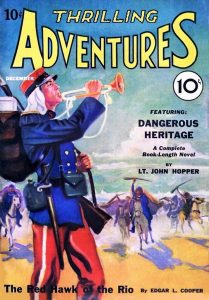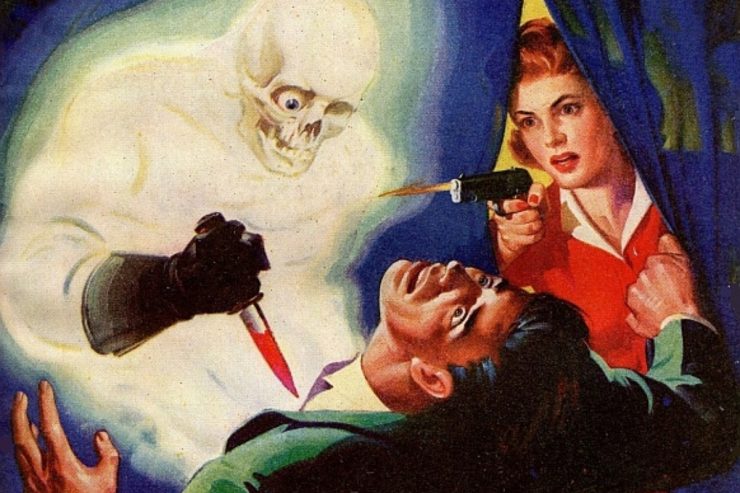Pulp magazines have influenced writers, artists, film directors, software developers, and countless others over the years. Our “Pulp History” articles focus on the rough-paper writers, editors, publishers, and artists who have inspired and continue to inspire the creators of the world’s popular culture.
 This month PulpFest celebrates the 90th anniversaries of Ned L. Pines’ Thrilling Detective, Thrilling Love, and Thrilling Adventures.
This month PulpFest celebrates the 90th anniversaries of Ned L. Pines’ Thrilling Detective, Thrilling Love, and Thrilling Adventures.
Pines was the publisher of the “Thrilling Group” of pulp magazines under various company names — Standard Magazines, Nedor Publishing, Better Publications, Thrilling Publications, and Beacon Publications.
The managing editor of the “Thrilling Group” was Leo Margulies, who had once worked for Munsey Magazines. Margulies was so highly respected by both authors and editors that he became known as “The Little Giant of the Pulps.” Together, Pines and Margulies hatched a plan to boost their sales during The Great Depression. Their brainstorm was to sell a ten-cent pulp magazine.
Thrilling Love and Thrilling Detective were the first in the “Thrilling” line of pulps. They arrived, at ten cents apiece, both dated November 1931. A companion magazine, Thrilling Adventures, followed one month later.
Thrilling Detective ran for 213 issues, finally folding in the Summer of 1953.
Thrilling Love ran for a total of 241 issues, concluding in the Winter of 1955.
Thrilling Adventures continued as a monthly until March 1943, when it was reduced to a bimonthly, with the final issue coming out in November of that year. A total of 139 issues was released.
The success of these first three “Thrilling Group” magazines allowed Pines to continue expanding his pulp line. By 1936 he was quoted as saying, “The total annual distribution of the twelve pulp magazines published under the name ‘Thrilling Group’ is around eighteen million copies per year.”
 On October 2, 1937, newspaper gossip columnist Don O’Malley from The Brooklyn Eagle reported, “About seven years ago, a young New Yorker named Ned Pines decided to go into the paper business. He got the idea of buying up a paper mill’s entire output at low prices for later re-sale. He discovered, however, that the best price for the paper could be obtained if it were sold in the form of a pulp magazine. Now Pines has about thirty publications, with a circulation of two million copies a month. He switches them on and off according to the profits they show. Pines can get out a new pulp title on a week’s notice or less — and he junks unprofitable magazines with equal abruptness.”
On October 2, 1937, newspaper gossip columnist Don O’Malley from The Brooklyn Eagle reported, “About seven years ago, a young New Yorker named Ned Pines decided to go into the paper business. He got the idea of buying up a paper mill’s entire output at low prices for later re-sale. He discovered, however, that the best price for the paper could be obtained if it were sold in the form of a pulp magazine. Now Pines has about thirty publications, with a circulation of two million copies a month. He switches them on and off according to the profits they show. Pines can get out a new pulp title on a week’s notice or less — and he junks unprofitable magazines with equal abruptness.”
The idea of entertainment for a dime was a big hit. We know that because the Thrilling lines were popular and persisted. We also hear it from the readers in the letters columns.
In the March 1932 issue of Thrilling Adventures, the winners were announced in a letter-writing contest with the topic of — “Why I like Thrilling Adventures.” Here is an excerpt from the winning entry by John S. Muranko:
 “When a fellow has to be cooped up in a stuffy office and take all of the boss’s bull and bulling without telling him where to get off at for fear of losing the job that spells bread and butter for his wife and two kids, and is still young and healthy and rarin’ to go but can’t let loose on account of the much needed B & B, it’s not always pleasant . . . . after supper is over . . . I come into my own. I make a dive for Thrilling Adventures that I bought merely out of curiosity and in no time after Tex Tolliver had wised me up a little. I became Tex and took the Red Hawk away from him and went after that Raider. All Tex said was ‘Go to it. She’s yours.’ I also became Billy Barrow and took care of that Riff because he looked a heluva lots like my boss.
“When a fellow has to be cooped up in a stuffy office and take all of the boss’s bull and bulling without telling him where to get off at for fear of losing the job that spells bread and butter for his wife and two kids, and is still young and healthy and rarin’ to go but can’t let loose on account of the much needed B & B, it’s not always pleasant . . . . after supper is over . . . I come into my own. I make a dive for Thrilling Adventures that I bought merely out of curiosity and in no time after Tex Tolliver had wised me up a little. I became Tex and took the Red Hawk away from him and went after that Raider. All Tex said was ‘Go to it. She’s yours.’ I also became Billy Barrow and took care of that Riff because he looked a heluva lots like my boss.
“Well it all went to show how real the stories sounded and then the thrifty little woman said ‘Only a dime? Well no one ever went wrong on a dime.’
“And then she’s more than pleased because her ‘big man’ is so much more pleasant after a dime’s investment.
“So that’s why WE like Thrilling Adventures.”
Between 1931 and 1958, Ned Pines published more than seventy rough-paper magazines. His title list was extensive and included Black Book Detective, Captain Future, Detective Novels Magazine, Exciting Love, Fantastic Story Quarterly, G-Men, The Phantom Detective, Popular Baseball, Popular Detective, Rodeo Romances, Startling Stories, Strange Stories, Thrilling Confessions, Thrilling Mystery, and Thrilling Wonder Stories, to name a few. He also began to publish comic books — America’s Best Comics, The Black Terror, Coo Coo Comics, Exciting Comics, The Fighting Yank, Happy Comics, New Romances, Real Life Comics, Supermouse, Thrilling Comics, and many others — beginning in 1939. Pines added paperback books to the company’s publishing roster in 1942, under the “Popular Library” banner. The book line was still going strong in 1977 when the company was purchased by CBS.
Success can be measured by being in the right place at the right time. Launching a publishing venture during The Great Depression does not, on the surface of it, seem as if it would be a recipe for success. And yet Ned Pines, with his line of “Thrilling” pulps, hit the market just right and thrived. We’re certainly glad that he did because some very fine stories were published in his magazines. Even more than that, we see that he helped many people find reassurance and escape during a very dark time. This last is not usually considered a marker for publishing success. But we call it that. The thrills of 1931 were about more than just sales. They were also about the expansive joy that Pines’ magazines brought to readers.
At PulpFest 50, we’ll be celebrating “Action for a Dime!” and more. The convention will run from Thursday, August 4, through Sunday, August 7, at the DoubleTree by Hilton Hotel Pittsburgh – Cranberry in Mars, Pennsylvania. See you there!
A professional journalist and illustrator with over thirty years of experience, Sara Light-Waller is an accomplished new-pulp fiction author/illustrator with two books out and more on the way. She is also the winner of the 2020 Cosmos Prize for her illustrated short story, “Battle at Neptune.” A huge pulp fan, Sara is especially fond of science fiction pulps. The extent of her pulp fandom can best be measured by the oversized rendition of Frank R. Paul’s August 1928 Amazing Stories cover that she painted on her garage. Sara is a member of the PulpFest organizing committee and a regular contributor to our website and The Pulpster.
Howard Sherman painted the cover for the November 1931 Thrilling Detective. Douglas Fontz contributed the pastel cover for the November 1931 Thrilling Love. The December 1931 Thrilling Adventures features a cover by J. George Janes. Many thanks to David Saunders for his help identifying these cover artists and for the 1937 Brooklyn Eagle quote cited in our post.







